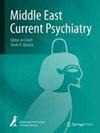Sensory processing patterns among children with autism spectrum disorder (ASD) and attention deficit hyperactivity disorder (ADHD) using short sensory profile and evoked potentials: a case–control study
IF 1.6
Q3 PSYCHIATRY
引用次数: 0
Abstract
Both autism spectrum disorder (ASD) and attention-deficit hyperactivity disorder (ADHD) are early neurodevelopmental disorders that present notable diagnostic problems and share clinical features. The current research intends to clarify the sensory profile, visual-evoked potential (VEP), and auditory-evoked potential of children diagnosed with autism spectrum disorder (ASD), ADHD, and typically developing children (TD). We have observed sensory processing problems in 42–88% of children diagnosed with autism and approximately 50% of children diagnosed with ADHD. The parents of 37 children diagnosed with ASD, 41 children diagnosed with ADHD, and 43 children who were typically developing completed the short sensory profile (SSP) along with standardized questionnaires used to assess the symptoms and autistic behaviors. We assessed intellectual functioning and evoked potential in all the groups. There were more sensory problems in the ASD and ADHD groups than in the control group (P < 0.001); however, autism and ADHD differed in all subscales except unresponsiveness, auditory filtering, and visual/auditory subscales. Also, the ASD group and ADHD group showed a more significant delay in visual-evoked potential VEP than the control group (mean and SD of right eye p100 latency 150.85 ± 48.70 in ASD vs 119.28 ± 18.06 in ADHD vs 103.42 ± 5.19 in typically developing group, left p100 latency 141.09 in ASD ± 32.55 vs 116.51 ± 10.1 in ADHD vs 103.0 ± 5.91 typically developing group). Additionally, the ASD group significantly deviated from norms in the absolute latency of waves I, III, and V, as well as the inter-wave intervals of I–III and III–V in the auditory-evoked potential. Furthermore, there was a statistically significant distinction between the ADHD and the TD groups in terms of left wave III and V latency and left interpeak latency between I–III and III–V. Children diagnosed with ASD and ADHD have a greater likelihood than typically developing children to experience sensory processing abnormalities; as a result, we recommend basic assessment, follow-up, and designing the most appropriate intervention.自闭症谱系障碍(ASD)和注意缺陷多动障碍(ADHD)儿童的感觉处理模式:一项病例对照研究
自闭症谱系障碍(ASD)和注意力缺陷多动障碍(ADHD)都是早期神经发育障碍,存在显著的诊断问题和共同的临床特征。目前的研究旨在阐明被诊断为自闭症谱系障碍(ASD)、注意力缺陷多动障碍(ADHD)和发育典型儿童(TD)的感官特征、视觉诱发电位(VEP)和听觉诱发电位。我们在 42-88% 的自闭症儿童和大约 50% 的多动症儿童中发现了感觉处理问题。37 名被诊断为自闭症的儿童、41 名被诊断为多动症的儿童和 43 名发育正常的儿童的家长填写了简短感觉档案 (SSP),以及用于评估症状和自闭症行为的标准化问卷。我们评估了所有组别的智力功能和诱发电位。与对照组相比,自闭症多动症组和多动症组存在更多的感官问题(P < 0.001);然而,除反应迟钝、听觉过滤和视觉/听觉分量表外,自闭症多动症组和多动症组在所有分量表上都存在差异。此外,与对照组相比,ASD 组和 ADHD 组的视觉诱发电位 VEP 出现了更明显的延迟(ASD 组右眼 p100 潜伏期的平均值和标度为 150.85 ± 48.70 vs ADHD 组为 119.28 ± 18.06 vs 典型发育组为 103.42 ± 5.19,ASD 组左眼 p100 潜伏期的平均值和标度为 141.09 ± 32.55 vs ADHD 组为 116.51 ± 10.1 vs 典型发育组为 103.0 ± 5.91)。此外,在听觉诱发电位中,ASD 组的 I 波、III 波和 V 波的绝对潜伏期以及 I-III 波和 III-V 波的波间间隔均明显偏离常模。此外,在左波 III 和 V 波潜伏期以及左波 I-III 和 III-V 波间潜伏期方面,ADHD 组与 TD 组之间存在统计学意义上的显著差异。被诊断为自闭症和多动症的儿童比发育正常的儿童更有可能出现感觉处理异常;因此,我们建议进行基本评估、跟踪和设计最合适的干预措施。
本文章由计算机程序翻译,如有差异,请以英文原文为准。
求助全文
约1分钟内获得全文
求助全文
来源期刊

Middle East Current Psychiatry
Medicine-Psychiatry and Mental Health
CiteScore
3.00
自引率
0.00%
发文量
89
审稿时长
9 weeks
 求助内容:
求助内容: 应助结果提醒方式:
应助结果提醒方式:


